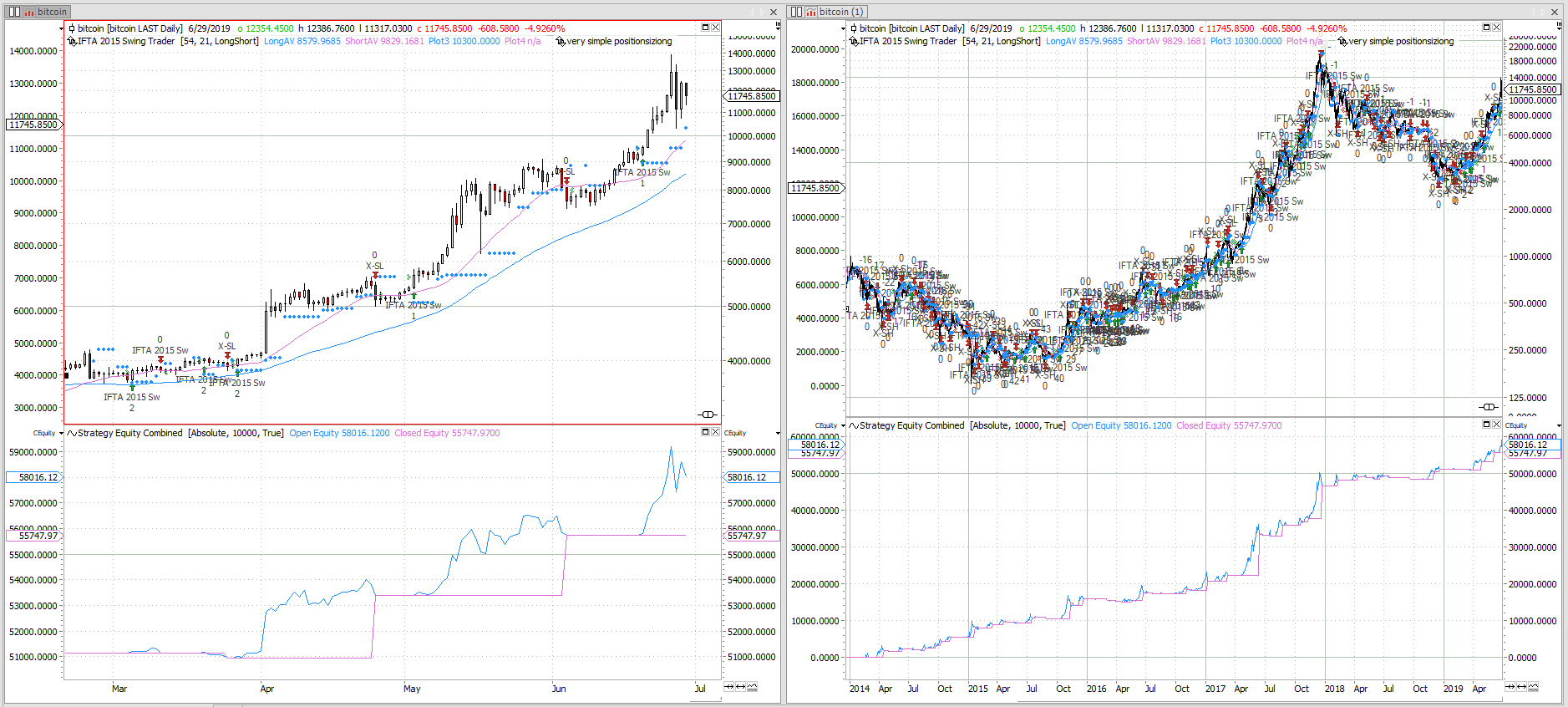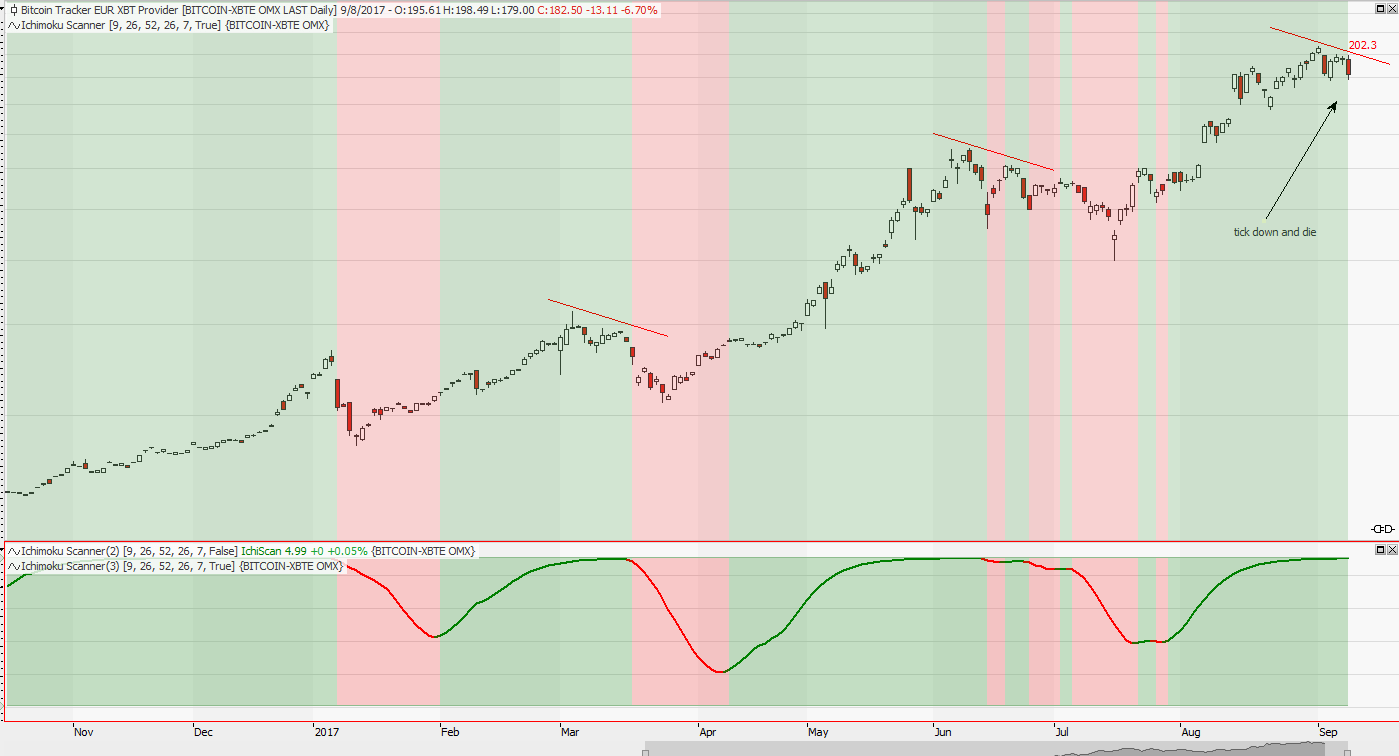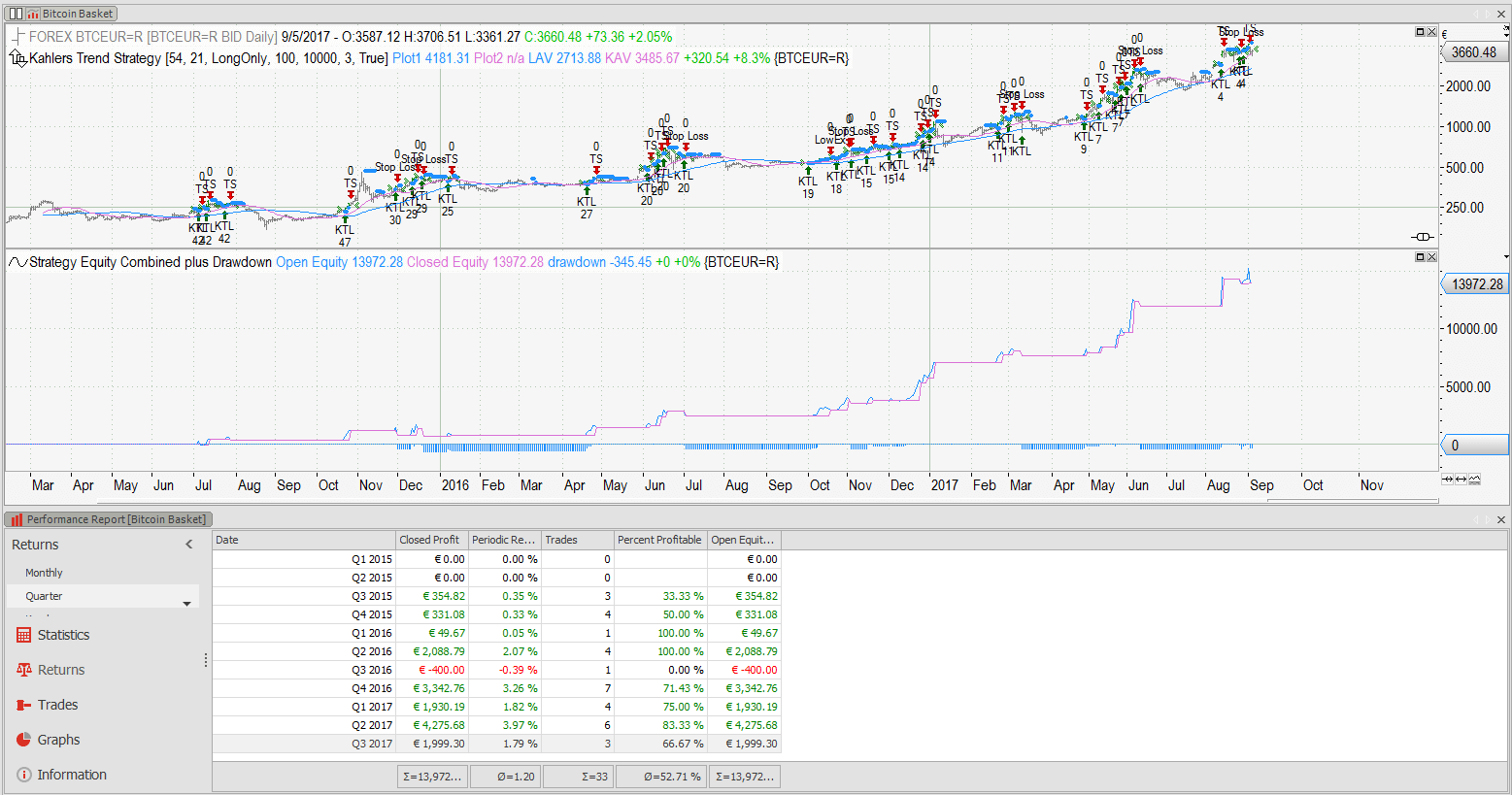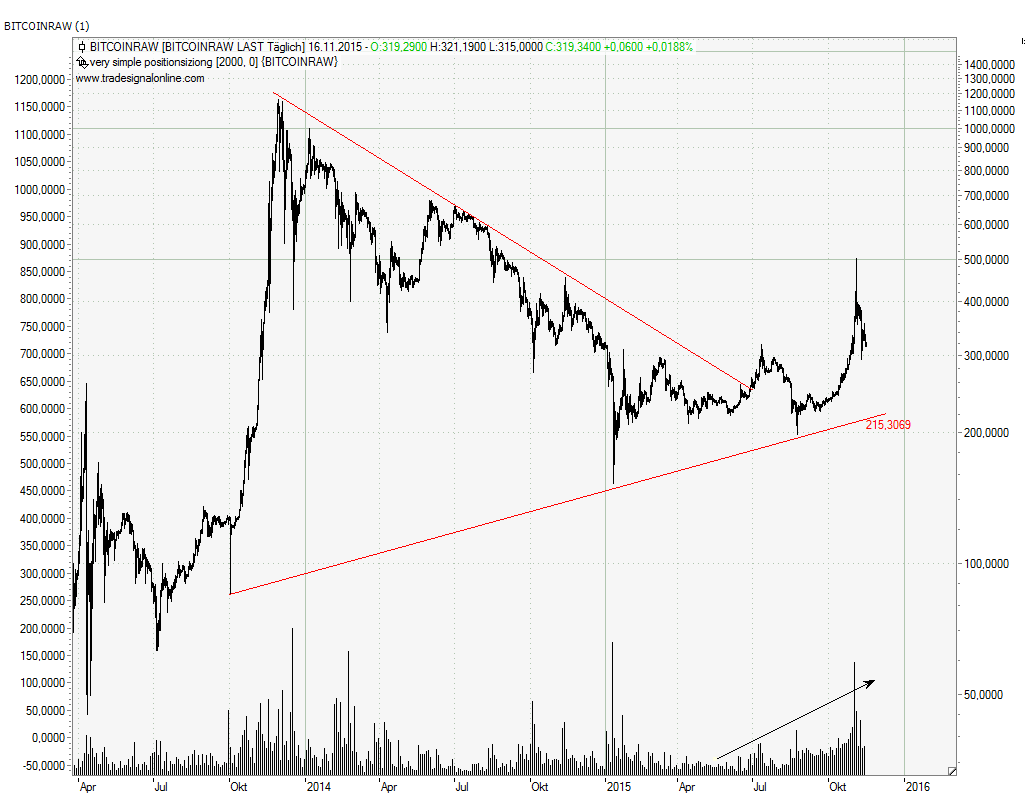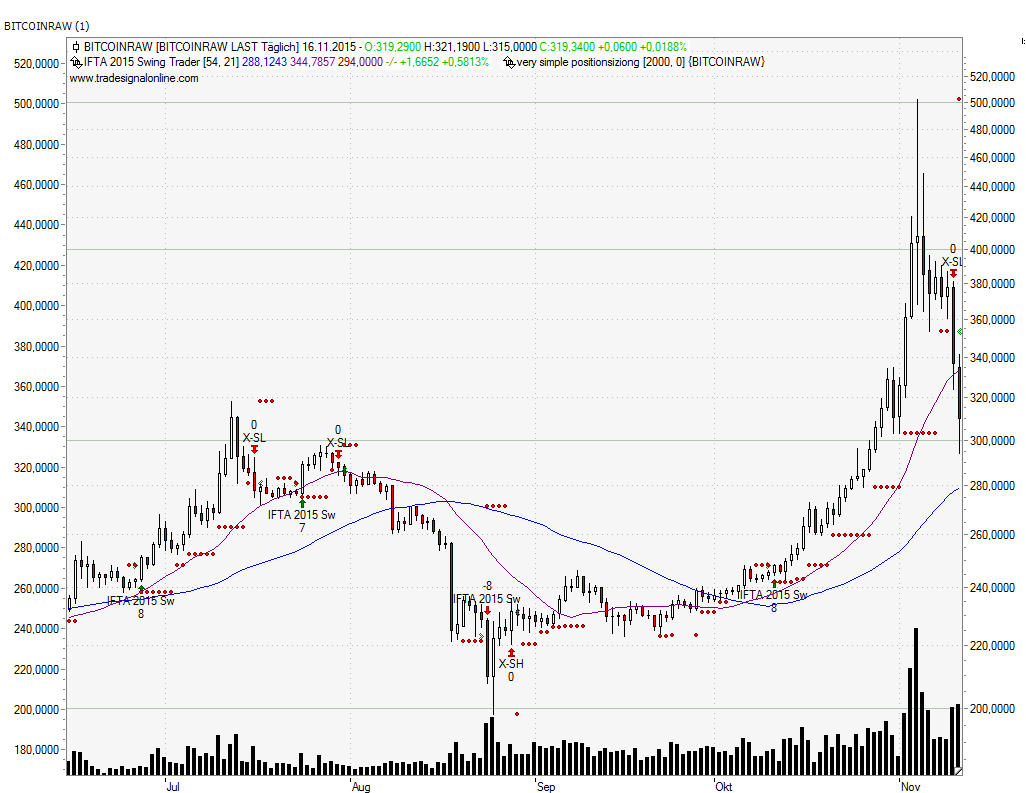the blog is closed and the domain quanttrader.com is for sale
Bitcoin
Bitcoin Swing Trading
I published a bitcoin swing trading strategy in 2015 over here (German only). Time to review the methodology of swing trading and have a look on the performance. Can a rational strategy get an edge in an irrational market? Have a look and be surprised! Continue reading
Bitcoin – end of the bullish bubble
Bitcoin has come a long way but now it is time to say good bye.
Being a trend following trader on the long side, the chart right now suggest anything else but a trend following long strategy. It might all look completely different in a few weeks or months, but right now the bitcoin market is done. The ichimoku scanner indicator still shows 100% bullish, but have a look at the history and the formed indicator-market patterns: As marked on the chart we can see a nice bearish divergence. This is not a long entry signal!
Lower highs, lower lows; goodbye bitcoin, loved to trade you, but with a bearish behavior like now you are not my friend any more.
Bitcoin Trading Strategy – review of returns
Bitcoin is not as bullish as it used to be. May it be due to fundamental reasons like transaction cost and slow speed, or maybe the herd found a new playground, whatever it might be, it is a good time to have a look how my bitcoin trading strategy performed.
The bitcoin trading strategy uses two moving averages for the trend detection, and, when the averages say bullish, the strategy will buy if the market moves above it`s old swing high.
The position is protected with an exit at the last swing low and a 3% trailing stop.
But have a look how this simple strategy performed over the last two years:
Trading on a daily timeframe and investing 10000€ with each entry, the strategy managed to get more than a 100% return over the last 2 years.
Bitcoin Handelsstrategie
Die Cryprowährung Bitcoin ist zurück!
Sie erlebte ihren Hype vor 2014, doch ging es seitdem fast nur noch bergab. Nach den Hochs um 1000$ für einen Bitcoin Ende 2013 verfiel der Preis bis auf 150$. Doch diese Zeiten scheinen vorbei zu sein, bitcoin is back!
Bitcoin Chart Analyse
Der Chart zeigt den Bitcoin / USD Verlauf der vergangenen 3 Jahre. Es spring sofort ins Auge, dass die lanfristige fallende Trendlinie im Juni 2015 gebrochen wurde. Seitdem ist neben den Kursen auch das gehandelte Volumen stark am Steigen. (Kurs- und Volumsdaten von bitstamp.net)
Noch immer ist die Volatilität des Marktes extrem hoch, Bitcoin ist ein reines Spekulationsobjekt, beliebt bei Leuten mit Hang zur Weltverschwörung. Dies sind die besten Voraussetzungen dafür, dass eine automatisches Bitcoin Handelssystem funktionieren kann. Die hohe Volatilität ermöglicht zudem mit geringem Kapitaleinsatz ansprechende Gewinne.
Bitcoin Handelsstrategie
ich bin nicht an die Börse gegangen um mir den ganzen Tag Gedanken über Trendlinien zu machen, ein automatischen Handelssystem für Bitcoin ist da schon eher mein Ding.
Meine Bitcoin Handelsstrategie basiert auf klassischem Swing Trading. Die Strategie selbst wurde auf von mir auf der IFTA Konferenz in Tokyo vorgestellt, IFTA Mitglieder können den vollständigen Systemcode auf der Webseite http://www.ntaa.or.jp/ laden.
Die Basis des System sind die Swing Punkte.
Eine programmierte Definition dieser Punkte finden Sie im Swing Point Stop
Kombiniert man diese Swing Punkte mit einer einfachen Trenderkennung, ergibt sich ein hoch profitables Bitcoin Handelssystem.
Bitcoin Handels Regeln:
Bitcoin Revolution
Cryptowährung Bitcoin
Die digitale Währung Bitcoin scheint nicht mehr aufzuhalten. Immer stärker wird die Verzahnung mit der Realwirtschaft, immer mehr Händler nehmen Bitcoin als Zahlungsmittel, immer mehr institutionelle Anleger können diesen Markt nicht mehr ignorieren.
Ich verbrachte die letzten 2 Tage mit Davide Capoti, Emanuele Colacchi und Matteo Maggioni in Rom. Die 3 sind institutionelle Commodity Händler für einen der größten italienischen Marktteilnehmer. Und als professionelle Händler schrieben Sie eines der professionellsten Bücher zu diesem Thema, derzeit leider nur auf italienisch erhältlich.
Bitcoin Trading
Das Buch Bitcoin Revolution ist in 3 große Abschnitte geteilt.

